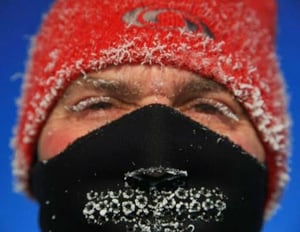 Hypothermia is the lowering of a person’s core temperature. It occurs when a person suffers a loss of body heat. General body hypothermia is the leading cause of death among recreational boaters and other emergencies at sea. If not recognized and treated promptly, hypothermia can rapidly turn survivors into fatalities.
Hypothermia is the lowering of a person’s core temperature. It occurs when a person suffers a loss of body heat. General body hypothermia is the leading cause of death among recreational boaters and other emergencies at sea. If not recognized and treated promptly, hypothermia can rapidly turn survivors into fatalities. Survivors in critical hypothermia conditions may suffer a fatal loss of body temperature from physical exertion, or as a result of any delay in taking immediate and positive measures to restore body heat. Struggling survivors, trying to aid in their own rescue, may drive their body temperature down to the point where unconsciousness and/or death results. Survivors removed from the water and left untreated may suffer further critical loss in body temperature, bringing on death after being rescued. Survivors in “warm” water can also suffer from hypothermia if exposed for long enough periods of time.
Cold air temperatures can bring on hypothermia if adequate protective clothing is not worn. Survival times in water vary considerably. Survival depends on the type of clothing worn, the amount of physical exertion, the blood alcohol levels, and other factors. Some survivors, when taken aboard may appear to be under the influence of drugs or alcohol. A person moderately hypothermic will show symptoms of an intoxicated person.
An important method of protecting yourself while operating your boat in a cold weather environment would be to properly layer your clothing. This method of dressing allows you to regulate your temperature by taking off or putting on additional clothing layers. Layers are broken down into three categories: Inner, mid, and outer. These three layers work together to trap heat, wick moisture, breath, block wind, and repel water.
- Base Layer: The base or wicking layer which should be worn next to your skin should be designed to move moisture away from your skin, keeping you dry and warm after bursts of activity.
- Mid layer: The middle or insulating layer is designed to be worn over the base layer and under the outer layer. Made of synthetic thermal fibers, it assists the movement of moisture to the outer layer.
- Outer Layer: The outer or waterproof layer is intended to keep the elements out. These usually have very little or no thermal properties, but are entirely water and windproof.




Let Us Know What You Thought about this Post.
Put your Comment Below.